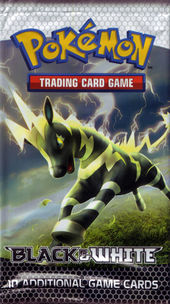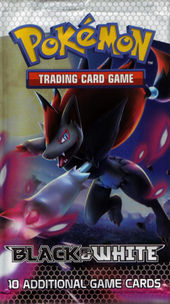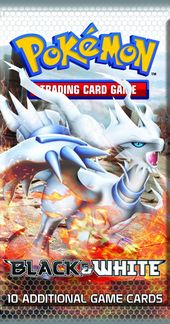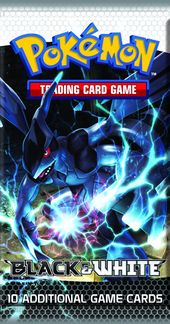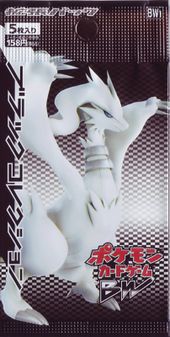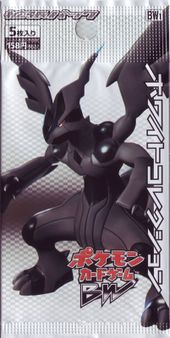
Black Collection • White Collection logos
Black & White is the name given to the first main expansion of the Black & White Series of the Pokémon Trading Card Game. In Japan, it was released as the Black Collection and White Collection dual expansions that make up the first expansion block in the Pokémon Card Game BW Era. It is based on Pokémon Black and White, featuring Generation V Pokémon and the two game Legendary Pokémon Reshiram and Zekrom. The English expansion was released on April 25, 2011, while the Japanese expansions were released on December 17, 2010. The concept of starting from a new beginning was brought into the Trading Card Game, thus Black & White was entirely composed of Generation V Pokémon, with the sole exception of Pikachu, which is a secret card.
Black & White introduced Ability, replacing the long-standing Poké-Powers and Poké-Bodies. Abilities essentially merge the active and passive effects of Poké-Powers and Poké-Bodies into a single mechanic, akin to Pokémon Powers present during the original and Neo Series. It also introduced Full Art cards. Full Art cards featured the artwork and Holofoil covering the entire card.
Several rule changes also came into effect with the release of Black & White. Item (named Goods in Japan), Supporter, and Stadium cards were reverted to being subclass of Trainer cards. They could once again be played during each player's first turn. The original rule that stipulated Supporter cards were to be discarded at the end of a player's turn had been changed to be discarded immediately after use. In Japan, Trainer cards were now written as "Trainer's" and Supporter cards were now written as "サポート". Neither of these changes had an effect on gameplay.
The procedure in which Knock Outs were carried out had been slightly altered. Previously, after the player with the Knocked Out Pokémon discarding that Pokémon, they would replace that Pokémon with one from their Bench, and the player performing the Knock Out would proceed to take one Prize card. This had been changed to the player performing the Knock Out taking one Prize card, then the player with the Knocked Out Pokémon replacing that Pokémon with one from their Bench. This change essentially prevented the player performing the Knock Out from selecting a Prize card based on their opponent's new Active Pokémon.
Black & White also introduced an updated card design, which included numerous changes. The card border of English prints were changed to yellow, while Japanese prints were changed to gray. The Stage area received a new graphic and were moved to the extreme top left with the Evolution circle below and the "Evolves from" beside the Evolution circle. There were curvy strips between the Pokémon's name and the HP, which gained additional layers upon evolving. The Weakness and Resistance were moved to the bottom left with the Retreat (shortened from Retreat Cost) below. The Pokédex entry was present on all Pokémon and was moved to the bottom right, inside of a frame. The copyright information was located on the extreme bottom left and the illustrator's name, card number and set symbol on the right. The Cosmos Holofoil was changed to a horizontal-striped pattern, named Tinsel Holofoil. In the Japanese prints, Holofoil were on the card border and the background of the artwork.
The English card ordering system was updated to be similar to the Japanese system that was introduced in ADV Expansion Pack. The Pokémon were ordered by type then by the National Pokédex number. All Trainer cards are listed in alphabetical order regardless of subtype or rarity. A new form of rarity symbol was implemented for the Japanese version. Instead of utilizing shapes to symbolize rarity, it was replaced by letters.  replaces
replaces  on Common cards,
on Common cards,  replaces
replaces  on Uncommon cards, and
on Uncommon cards, and  replaces
replaces  on Rare cards.
on Rare cards.  were Full Art cards and
were Full Art cards and  were Secret cards.
were Secret cards.
The booster pack size for Japanese expansions were reduced from 11 to 5 and include a card advertising the TCG and several related products. The price of a booster pack was reduced from ¥300 to ¥150, making the packs more within the price range of a younger target audience. The chance of getting a Rare card was also reduced to 1 in 2 packs, as opposed to a guaranteed Rare card. Mirror cards introduced in the HeartGold Collection and SoulSilver Collection were also discontinued.
The focus of starting afresh and the aim to involve younger children in the TCG in Japan was further emphasized with the redesign of the official Pokémon card website. Much of the new content was simplified and broken down into step-by-step guides with regards to the basics of the TCG. A great deal of past information, including the trading card database was temporarily moved to the Pokémon Card Game Network site, accessible only via a Pokémon Daisuki Club account.
The Pokémon Trading Card Game Online was introduced to the international players, which allowed users to select an avatar and battle computer-controlled opponents in simulated card battles. Players could select a number of pre-constructed decks to use, or add to their online collection by scanning the QR codes of special cards included in booster packs and Theme Decks accompanying the expansions. The first print run of Black & White did not include the QR code cards, and was made available in later print runs.
The Black Collection and White Collection sets are released in Japanese and Korean. The Japanese sets are available in both 1st and unlimited edition, and the Korean set only in unlimited edition. The Black & White set is released in English, German, French, Italian, Spanish, and Portuguese. Cards in the English, German, French, Italian, and Spanish set were also available as Reverse Holos. The Portuguese version of this set lacked any Reverse Holos.
![]() replaces
replaces ![]() on Common cards,
on Common cards, ![]() replaces
replaces ![]() on Uncommon cards, and
on Uncommon cards, and ![]() replaces
replaces ![]() on Rare cards.
on Rare cards. ![]() were Full Art cards and
were Full Art cards and ![]() were Secret cards.
were Secret cards.


